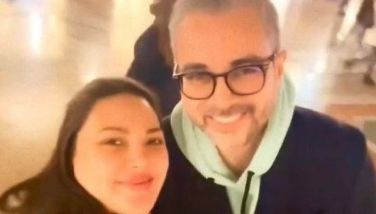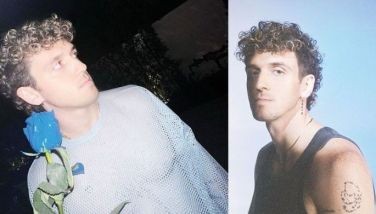Balik-balik sa Bohol
PANGLAO, BOHOL — It’s beautiful to wake up here in Bohol and easy to fall in love with the place and the people. This was where my husband and I had our first out-of-town trip, and I can’t forget that visit — taking the Loboc river cruise, visiting the centuries-old churches, having a close encounter with a tarsier and having our photo taken on a broomstick overlooking Chocolate Hills and diving and snorkeling in the waters in Balicasag. I love it here.
I was in Manila when I read about the earthquake that struck the province on Twitter. A 7.2 magnitude? I brushed it aside, and assumed that perhaps nothing major happened. Within minutes, images of fallen churches spread over social media. I thought to myself, “How are the people?â€
In my previous columns, I’ve written about the strength of the human spirit, and after meeting the Boholanos in my previous visits, so welcoming and warm and calm, I was really hoping they were coping well.
Upon our arrival here via Tagbilaran, our first stop was a provincial hospital, the Celestino Gallares Hospital. For a calamity so widespread and with patients being continuously admitted, the hospital grounds were organized. This was Day 3 after the quake. They had a white board with the names of all the patients outside the hospital, and on the entrance was a donation desk. The hospital staff members were on three-day shifts — a code red. But all their drills and preparations for a calamity paid off.
The infants were back in the nursery. A few days ago, the ambulance parking lot served as their neonatal area. The hospital nurse brought the babies outside, but even without rest and obviously tired, the male nurse still managed to smile at me.
They all seemed collected and pleasant. Where were the patients, the earthquake victims?
The surgery section was teeming with patients. During my visit, there were 140 plus patients and the number was constantly increasing. Beds were all occupied and most of the patients had bruises. I stopped when I saw one-year-and-eight-month-old Christopher Jr. His eyes were bloodshot and he was black and blue all over, with bruises in his arms and legs. It took his father 10 minutes to dig him out of the rubble, but thankfully, the boy survived.
Then I met Salome.
Salome was in one of beds at the corridor of the surgery area of the hospital. Her right arm was amputated because of the injury it sustained during the quake. I thought it would be awkward should I approach her, but she smiled at me. She told me that she was still in pain, at the right side of her rib. Salome narrated that the wall fell on her, and woke up with her arm amputated.
Throughout our conversation, there was pain in her smile, but she was not crying. “Are you really this brave?†I asked her.
She replied, “We can’t do anything about it, anyway. I’m just worried if I can still go back to work.â€
“She’s really brave,†her sister interjected, adding, “Boholanos are really like that.â€
During this time of adversity, I’d like to believe that Salome is the face of calmness inherent in Boholanos.
On my second day here, we visited the Bohol Cultural Center and I witnessed the Bayanihan spirit of Boholanos. There were so many volunteers, mostly from youth organizations. The relief goods covered almost every area that it was hard to walk around. It was Boholanos helping fellow Boholanos.
Even local LGUs were sending help and volunteers to different towns. Some diving operators have stopped operations to Balicasag Island because they were shuttling their relief goods to other towns in Bohol.
Actually, it should not come as a surprise.
Whenever we would appeal for donations for victims of calamity in Luzon, Metro Manila or Mindanao, many if not majority of the donations come from Cebu and Bohol. Visayan power! Some of the volunteers at the Bohol Cultural Center were victims themselves, but they chose to help because “I know how it feels to lose a home.â€
Aside from the destruction to homes and lives, what came as a shock to the outside world and Boholanos are the churches that are now ruins. For one Boholano I spoke to, it was very painful to see the churches collapse.
The Assumption of Our Lady Shrine in Dauis that was built in 1697 is now in ruins, and during one of our live telecast during Umagang Kay Ganda, I was surprised to see people hearing Mass behind the church. I couldn’t help but call Cardinal Luis Antonio Tagle to share what I saw. “The people are the Church!†This is what church means. I remembered St. Francis, too. Cardinal Tagle told me that it was his talk in the Philippine Conference on the new evangelization at the University of Sto. Tomas — “Faith arising from the ruins.â€
I went to the church annex to talk to the priests in Dauis. Ate Virgie led me to the church annex. I didn’t want to enter the building seeing that the main church already collapsed. It reminded me of the beautiful Baclayon Church. It’s sad to talk about it in the past tense.
Anyway, I saw the three priests, Fr. Jingboy, Fr. Joselito and Fr. Victor having breakfast. “Father, why are you still here, this building might collapse!†Fr. Jingboy said, “I’m ready to die.†“I’m not!†I replied.
We had eggs and fish and we were sharing stories about the quake. Minutes after, there was an aftershock. It felt like a bumpy train ride — the kind of ride wherein you would think the train would get derailed. I could imagine the big stones falling on us like UNO blocks.
Frankly, I think I’d die of panic in an earthquake because I don’t know what to do. Then, I felt someone hold my left hand. “Stay calm. Let’s walk slowly to the balcony.†Ate Virgie was giggling when she saw my face as white as a ghost.
I said, “Not fair, you three priests are ready to die, and I’m not!†We all laughed.
But on a serious note, they believed that the trial happened to Boholanos for them to forget about differences and be united, and they, too, hoped that even if the churches are now in ruins, not the faith. “More people hear Mass now,†said Fr. Victor.
The quake that literally shook Bohol is what brought them even tighter. Boholanos are very admirable and witnessing them united is seeing hope unfold. Hope is in the present tense, not in some far and unknown future.
Hope is happening in Bohol.
I will miss the historical places that made Bohol known, but after this tragedy, I can really say, that what sets a place apart from the rest, is its people.
As the Cebuanos and Boholanos would say after your visit, “Balik-balik lang (come again and again) sa Bohol.â€
Our prayers go to all the victims of the quake. For your comments, e-mail me at [email protected].
- Latest
- Trending































